Day 3 of a three day long weekend of tours today, our last day. It was lovely weather to be out and about – lots of sunshine and only patchy cloud, and a light SW breeze to keep the humidity down.
We started the day with a walk out over the grazing marshes at Burnham Overy. There were lots of warblers singing in the hedges, but they weren’t all making themselves easy to see today. A Blackcap was hiding in the bushes from where it we could hear its melodic song, and the Common Whitethroats were being unusually skulking this morning too. A Cetti’s Warbler typically shouted at us from deep in the undergrowth. A Chiffchaff was more amenable, working its way round the leaves in the tops of an oak tree, alternating looking for food and singing.
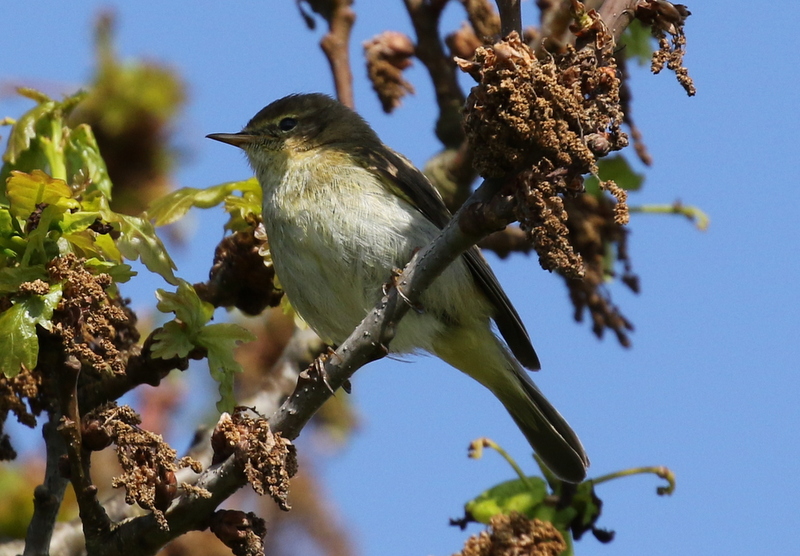 Chiffchaff – singing in the top of an oak tree by the path
Chiffchaff – singing in the top of an oak tree by the path
There were plenty of Sedge Warblers along the path too, and even they were not posing quite as well as they normally do today. A Lesser Whitethroat stuck its head out of a hawthorn briefly, then flew round across the path and into another bush.
An approaching family party of Long-tailed Tits gave themselves away with lots of calling, and we stopped and watched them as they fed in the bushes next to us for a short while, the adults busy collecting food and the sooty faced juveniles begging noisily. As quickly as they arrived, they then departed across the path and away down the hedge line.
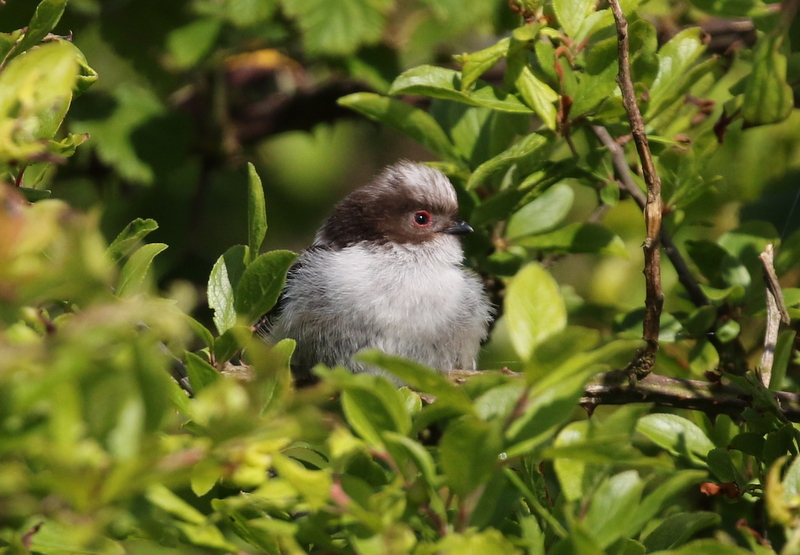 Long-tailed Tit – a juvenile enjoying the morning sun in the hedge
Long-tailed Tit – a juvenile enjoying the morning sun in the hedge
Stopping to scan the grazing marshes, we could see lots of geese out on the grass – with the winter geese now almost entirely departed, they were mainly Greylag Geese but also several Egyptian Geese with them. There were waders too, Avocets nesting round the little pools which had benefited from some overnight rain, plus a few Lapwings, Oystercatchers and a Redshank, all of which breed here.
Looking ahead, a large white shape in one of the deeper pools further along was a Spoonbill, feeding vigorously, head down, sweeping its bill from side to side as it walked round. We hurried along to where we were alongside it and had a fantastic view of it. It was an adult, with mustard wash across the breast, shaggy crest and, when it lifted its head occasionally, a yellow tip to its black bill.
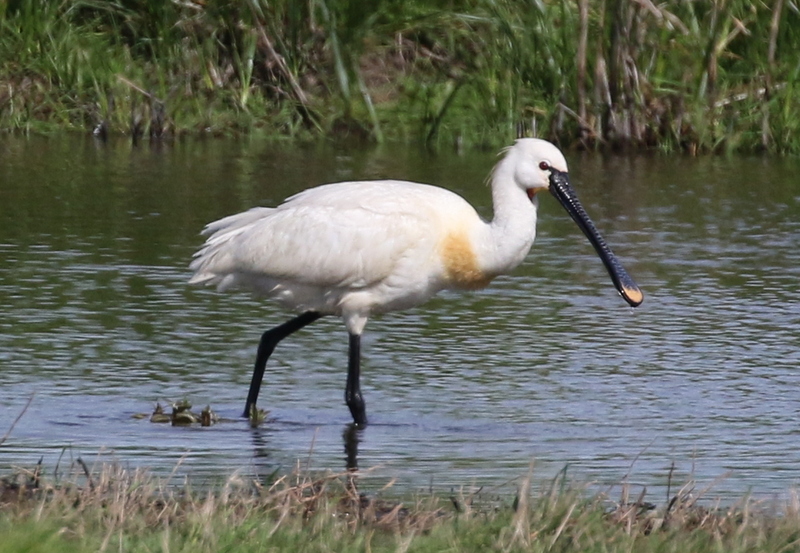 Spoonbill – feeding in one of the shallow ponds by the path
Spoonbill – feeding in one of the shallow ponds by the path
Some video of the Spoonbill feeding is below:
Eventually, the Spoonbill walked up out of the pool and across the grass, descending into another pool a little further back, so we moved on. A Reed Warbler was singing from the feeds by the ditch as we got to the gate at the far end, and another two Reed Warblers were chasing each other round on the other side of the path. Finally, we found a Sedge Warbler performing as they should, perched high on some brambles, out in the open, singing away.
Climbing up onto the seawall, we could see across the harbour. The tide was out but there were not so many waders here now, with most of the birds which had spent the winter here having departed north for the breeding season. There were a few more Avocets and Redshanks out on the mud.
As we walked past the reedbed, we could hear a Reed Bunting singing and found it perched on the top of a bush right out in the middle of the reeds. We heard a Bearded Tit ping briefly, but we couldn’t see any sign of it. A Marsh Harrier quartered the reeds at the back.
Continuing on out along the seawall, there were several Linnets in the bushes on the edge of the saltmarsh. A Skylark flew in across the path and landed down on the grass. We managed to get it in the scope, just in time to see a small head appear out of the grass next to it, bill open, begging for food, one of its hungry brood. We could hear a Redshank alarm calling and looked over to see a pair on the grazing marsh not far from the fence. The male, much more heavily streaked with black below, was piping loudly from a tussock, while the plainer female fed quietly in the grass.
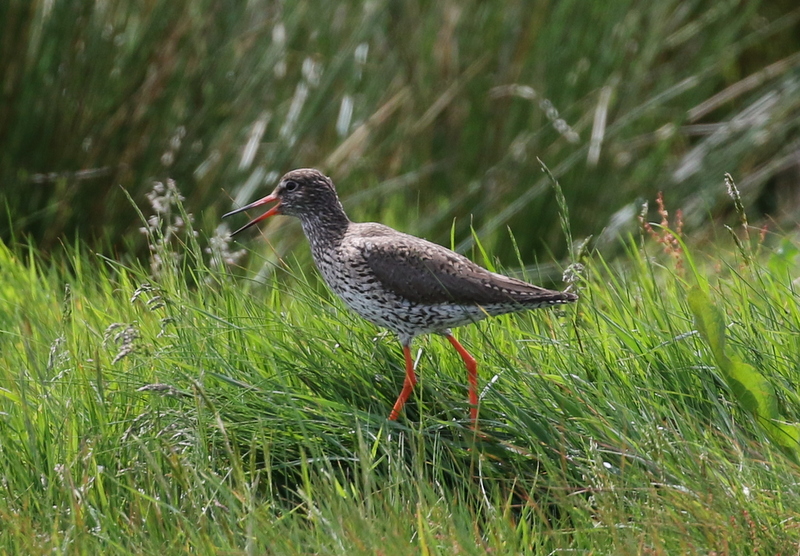 Redshank – the heavily marked male was piping loudly
Redshank – the heavily marked male was piping loudly
The seawall is a great vantage point, so as we walked, we scanned the skies. A small falcon appeared from the direction of the dunes. It was a long way off, but as it turned and flew west over the boardwalk, we could see it was a Merlin. This is a winter visitor here in Norfolk, so this was a late one, which should soon be on its way back to the moors to breed. We watched as it disappeared off towards Scolt Head. A few minutes later, we picked up another falcon, this time a Hobby, circling over the grazing marshes, hawking for insects. In contrast to the Merlin, the Hobby is a summer visitor here.
We could see quite a number of Swifts in the sky too this morning. They seemed to be on the move today, with birds passing west, occasionally stopping to hawk for insects up and down the seawall. We were almost at the boardwalk when we heard a Yellow Wagtail call and looked across to see it flying over the grazing marshes. It didn’t stop unfortunately, but continued on west, over the seawall behind us and out across the saltmarsh. Another migrant on its way.
From the boardwalk, we walked east into the dunes. We quickly found our target, Wheatears. One female was down on the short cropped grass, standing still by the entrance to a rabbit burrow. A second female was perched on a fence post a little further along, by the path. As a group of walkers came along the path towards us, this second Wheatear flicked along the line of posts towards us, before finally flying off back into the dunes beyond.
 Wheatear – flushed from along the fence line by a group of walkers
Wheatear – flushed from along the fence line by a group of walkers
It was nice to see the female Wheatears, but we really wanted to find a male. We walked a little further into the dunes, to an area favoured by Wheatears, and quickly found another two females. As we turned and started walking back, a male had appeared with the female from earlier, on the other side of the fence. It was a cracking bird – with a smart black bandit mask. When it turned, it was rich orangey on the throat and breast – a male Greenland Wheatear. The later migrants which pass through here are mostly of the Greenland race, and the males are more richly coloured below than the nominate form which breeds further south.
Given the sunny weather, there were not surprisingly good numbers of butterflies out in the dunes today. Wall Brown was the most numerous, but we also saw a couple of Small Copper and a single Small Heath. The Cinnabar Moths are also on the wing at the moment, brightly coloured day-flying moths, they are unpalatable to predators.
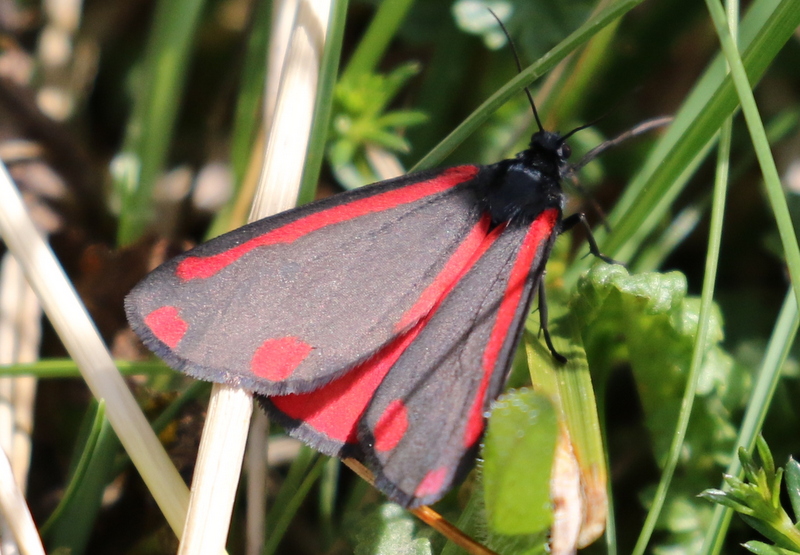 Cinnabar – a brightly coloured, and unpalatable, moth
Cinnabar – a brightly coloured, and unpalatable, moth
We would not be able to explore the dunes fully today, so we made our way back to the boardwalk and had a quick look out at the beach. Being a sunny Sunday, there were quite a few people – and dogs – out on the sand. We could see a few Sandwich Terns and Little Terns offshore, but as the tide was out, they were quite distant. We turned to head back.
The seawall was very busy now, as we walked back, with lots of people out for a stroll in the sun. A male Reed Bunting perched up nicely for us, singing in the bushes by the edge of the saltmarsh. We got a much improved view of it, compared to the one we had seen distantly out in the the reedbed earlier.
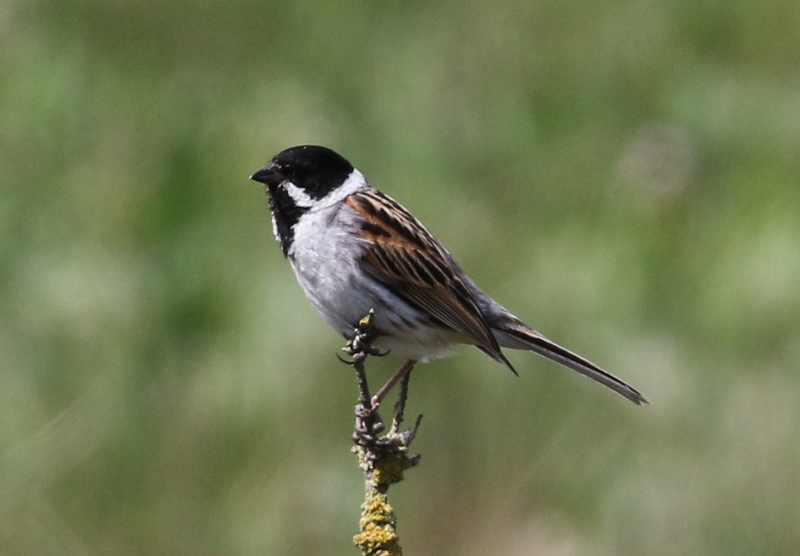 Reed Bunting – singing on the edge of the saltmarsh on the walk back
Reed Bunting – singing on the edge of the saltmarsh on the walk back
We stopped again by the reedbed to listen for Bearded Tits. We hoped we might at least hear one and perhaps see one whizzing over the tops of the reeds. A Bittern booming very distantly was a nice bonus while we listened. We heard snippets of Bearded Tits ‘pinging’ at first, but couldn’t see any. Then a male Bearded Tit appeared out in the middle of the reeds briefly, climbing up to the top of a stem, but dropping down again before everyone could get onto it.
We thought that might be the best of it, but we heard more ‘pinging’ closer to us and then another male Bearded Tit came zooming over the reeds towards us. Even better, it came right to the front of the reedbed and dropped down on the edge of grass just below the bank. This time we got a great look at it.
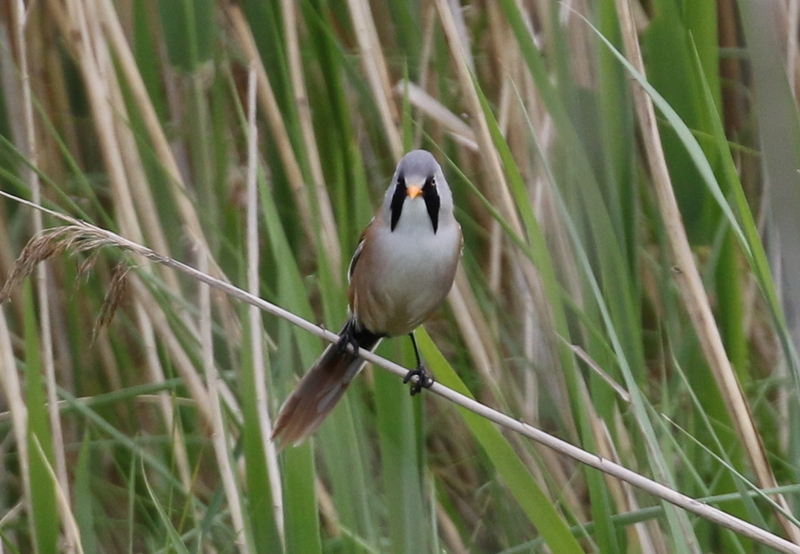 Bearded Tit – this male eventually came right out on the front of the reedbed
Bearded Tit – this male eventually came right out on the front of the reedbed
It was a real bonus to get such great views of a male Bearded Tit, so we headed back to the car well pleased with the morning’s birding. We made our way round to Holkham for lunch and surprisingly given the weather, Lady Anne’s Drive was not too busy and we were able to get a picnic table. A couple of Jackdaws were hopping over the other tables looking for crumbs. Two Spoonbills flew over while we were eating, heading back to the colony, presumably from the saltmarsh out beyond Wells. We finished our lunch with an ice cream from the van nearby – it felt just like summer in the sunshine!
After lunch, we had a quick walk out west on the inland side of the pines, up to the hides. There were still several warblers singing in the trees – a Blackcap or two, several Chiffchaffs and Common Whitethroats. We could hear more Long-tailed Tits calling from the pines. We managed to find a Coal Tit, up in the top of a tree, calling, where we could get it in the scope.
We were alerted to the presence of a Jay by various birds alarm calling, and it flew towards us and landed in a pine tree. It perched there for several minutes, preening and enjoying the sunshine, before dropping down to the ground and hunting around in the leaf little close by, giving us a great view.
 Jay – sunning itself in a pine tree, on the way out to the hides
Jay – sunning itself in a pine tree, on the way out to the hides
Up in the Joe Jordan Hide, there was a steady stream of Spoonbills coming & going. Several were bathing and preening on the edge of the pool in front of the hide, and a couple were still collecting nest material around the edge. When two Spoonbills flew up out of the trees, one looked quite a bit smaller than the other. As they banked, we could see that the smaller one had a very short bill. It was a juvenile, one of this years young, already fledged and presumably taking one of its first flights. They dropped back into the trees again.
There was lots of other activity here. Little Egrets were coming and going too, and a Grey Heron flew in as well. There were lots of Cormorants in the trees. A Marsh Harrier gave us a great close fly by, though it was too quick for the cameras – we were a bit slow in the after lunch lull! We could have sat here enjoying the view for longer, but we had one more destination we wanted to fit in this afternoon, so we packed up and walked back to the car.
We made our way back east and over to Stiffkey Fen. As we walked down along the footpath by the road, a Lesser Whitethroat was singing from the trees on the other side. A male Marsh Harrier circled up over the wood, calling. As we got across the road and onto the footpath by the river, we found a tree had come down across the path. Thankfully everyone was game to clamber over. With the two stiles here as well, it was a bit of an assault course to get to the Fen today!
Down along the edge of the river, there were more warblers singing – Chiffchaff, Blackcap and Common Whitethroat. From the reeds around the edge of the Fen, we could hear Sedge Warbler and Reed Warbler too. From up on the seawall, we could see the tide was in now. An Avocet was feeding along the edge of the flooded channel.
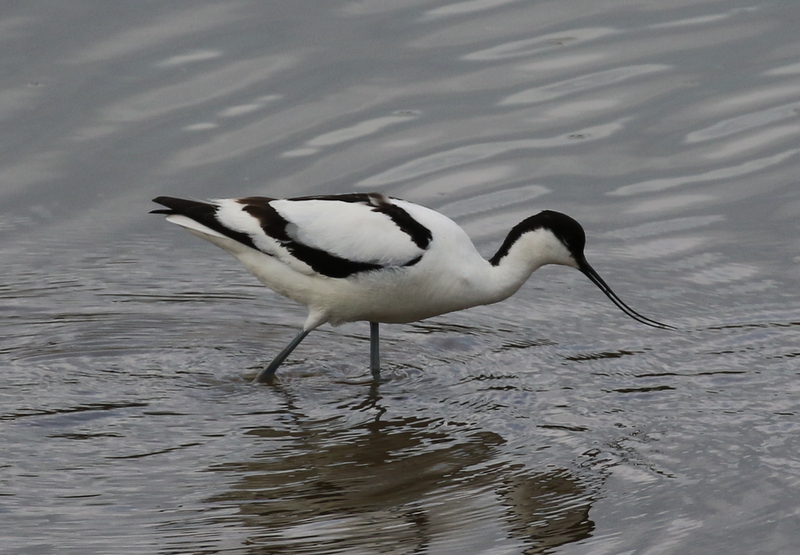 Avocet – feeding in the channel below the seawall
Avocet – feeding in the channel below the seawall
We stopped on the bank to scan the Fen. We had glimpsed a Little Ringed Plover on one of the islands on the walk out, but it wasn’t in the same place now. Thankfully, it didn’t take too long to find it, on one of the other islands. This is normally a good place for Black-tailed Godwits, but there was only one here today – not in full summer plumage, but this one did at least have some rusty feathering on the breast. The only other waders on here today were the Avocets.
Three Wigeon were feeding on the edge of one of the islands. They are common here in winter, but the vast majority have now left for Russia for the breeding season, leaving just these three behind. Otherwise the Fen was dominated by gulls – as well as the breeding Black-headed Gulls, we could see several Lesser Black-backed Gulls with the Herring Gulls, and a couple of young (1st summer) Common Gulls.
Walking down along the seawall, we could hear a Cuckoo singing in the distance. It seemed to be getting a little closer, so we had a scan of the trees on the far side of the Fen. The Cuckoo was perched on the edge of the last tree. We got the scope on it and could see it singing. Then we continued on round to have a look at the harbour.
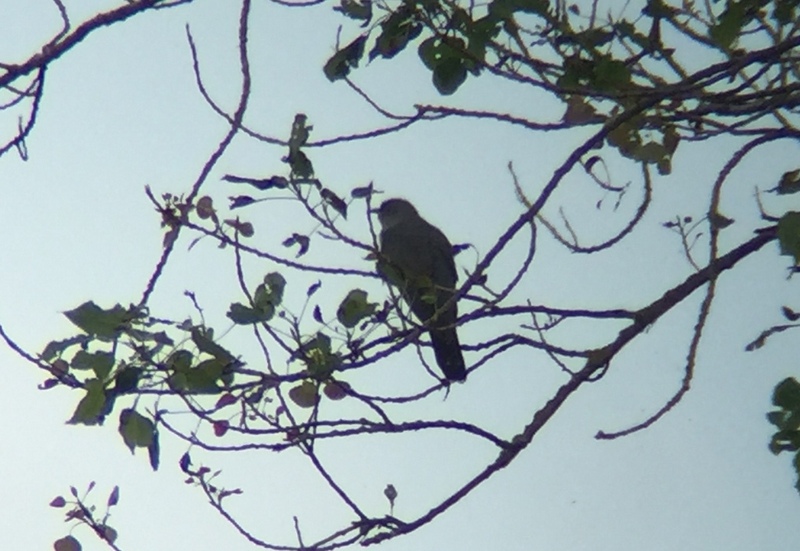 Cuckoo – singing from the trees beyond the Fen
Cuckoo – singing from the trees beyond the Fen
The harbour looked rather quiet at first, but as we scanned over the remaining mud, we found more birds. There were plenty of Oystercatchers, with a large group roosting on one of the spits ahead of the incoming tide. There are not so many other waders here now, but a careful scan revealed a few still. A little group of Ringed Plover were well camouflaged on the mud, until they moved. Three Dunlin were nearby, all sporting black belly patches now. A smart summer plumage Turnstone appeared on the mud too.
A small group of Brent Geese were feeding on the edge of the water, again late lingering winter visitors (most of the many Brent Geese which are here through the winter have long since departed). There are very few terns on Blakeney Point again this year, after the rat infestation last year caused most of them to decamp to Scolt Head instead. There were two Little Terns resting on the mud on the edge of the water. We got them in the scope and could see their black-tipped yellow bills and white foreheads.
As we started to make our way back, we could hear a Mediterranean Gull calling. Up on the seawall, we stopped to scan the Fen, and heard what we presumed was the same bird calling behind us, over the edge of the harbour. We looked round to see a 1st summer Mediterranean Gull flying across over the saltmarsh. It circled round, encountering some half-hearted aggression from a couple of the Black-headed Gulls, before flying in over the seawall to the Fen. When it dropped down onto one of the islands, we noticed there was another 1st summer Mediterranean Gull on there already.
 Mediterranean Gull – a first summer which dropped in to Stiffkey Fen this afternoon
Mediterranean Gull – a first summer which dropped in to Stiffkey Fen this afternoon
Unfortunately, it was now time to be heading back. On the way, there were several butterflies in the brambles, Peacocks and Red Admirals enjoying the afternoon sun. In the field by the layby, we could see two Red-legged Partridges and several Brown Hares hiding in the fast growing wheat.
 Red Admiral – enjoying the afternoon sun on the brambles
Red Admiral – enjoying the afternoon sun on the brambles
It had been a very enjoyable day’s birding today, in the sunshine, to round off a very productive three days. We made our way back to Wells, to end the tour.
















